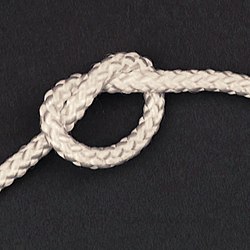Difference between revisions of "Translations:AY Honors/Braiding - Advanced/Answer Key/21/en"
From Pathfinder Wiki
(Importing a new version from external source) |
(Importing a new version from external source) |
||
| Line 1: | Line 1: | ||
</noinclude><!-- instance 1 --> | </noinclude><!-- instance 1 --> | ||
<!-- 5. Know how to start and end all projects. --> | <!-- 5. Know how to start and end all projects. --> | ||
| − | {{: | + | {{:AY Honors/Braiding/Start}} |
Latest revision as of 21:34, 17 September 2021
How to start or end depends on the material being braided.
Starting
- Rope, string, or lace
- Lay the ropes (or strings or laces) parallel to one another with the ends even and tie an overhand knot in the entire bundle.
| Tying the Overhand Knot |
|---|
|
Use: one of the most fundamental knots and forms the basis of many others including the simple noose, overhand loop, angler's loop, reef knot, fisherman's knot and water knot. The overhand knot is very secure, and can jam badly, so only use if you want a permanent knot. It is often used to prevent the end of a rope or string from unraveling.
|
- Hair
- Bind the hair you wish to braid using an elastic band near the head. Divide into the desired number of equal-diameter strands.
- Leather
- A wide leather strap can be cut into strips, but left intact near one end.
Ending
- Rope, string, or lace
- Tie the bundle into an overhand knot.
- Hair
- Bind the braid with a rubber band or a decorative hair elastic.
- Leather
- Glue the strands in place, rivet them to another piece, or firmly sandwich them between two other pieces of leather.


